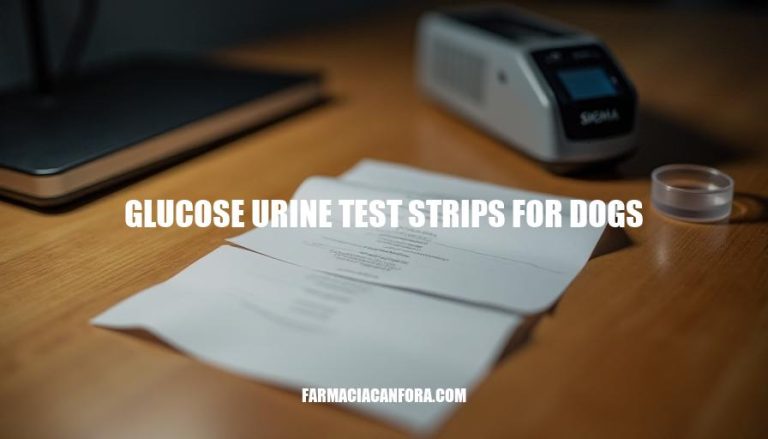Glucose urine test strips for dogs are a simple and effective tool used to monitor the presence of glucose in a dog’s urine. These strips are particularly important for managing diabetes in dogs, as they help pet owners and veterinarians track glucose levels and adjust treatment plans accordingly. Regular monitoring with these strips can help detect changes in a dog’s health early, ensuring timely intervention and better overall management of the condition.
How Glucose Urine Test Strips Work
Glucose urine test strips for dogs work through an enzymatic reaction. Here’s how they detect glucose levels:
- Sample Collection: The strip is dipped into the dog’s urine sample.
- Enzymatic Reaction: The strip contains glucose oxidase, an enzyme that reacts specifically with glucose.
- Color Change: This reaction produces hydrogen peroxide, which then reacts with a chromogen on the strip, causing a color change.
- Reading Results: The color change is proportional to the glucose concentration and is compared against a color chart to determine the glucose level.
This method provides a quick and easy way to monitor glucose levels in a dog’s urine.
Benefits of Using Glucose Urine Test Strips for Dogs
Here are the advantages of using glucose urine test strips for dogs:
- Early Detection of Diabetes: Helps identify high glucose levels early, allowing for timely intervention.
- Ease of Use at Home: Simple to use, making it convenient for regular monitoring without frequent vet visits.
- Non-Invasive: No need for blood samples, reducing stress for both the dog and owner.
- Cost-Effective: Generally more affordable than frequent blood tests.
- Immediate Results: Provides quick feedback on glucose levels.
How to Use Glucose Urine Test Strips for Dogs
Here’s a step-by-step guide to using glucose urine test strips for dogs:
- Gather Supplies: Test strips, a clean container, and gloves.
- Collect Urine Sample:
- Use a clean container to catch your dog’s urine midstream.
- Prepare Test Strip:
- Remove one strip from the container and close it tightly to avoid contamination.
- Dip the Strip:
- Fully immerse the test strip in the urine sample for 1-2 seconds.
- Remove Excess Urine:
- Tap the strip gently on the edge of the container to remove excess urine.
- Wait for Reaction:
- Lay the strip flat and wait for the specified time (usually 30-60 seconds) as indicated by the manufacturer.
- Read Results:
- Compare the color change on the strip to the color chart provided on the test strip container.
- Record Results:
- Note the glucose level and any other relevant information.
Tips for Accurate Results:
- Fresh Sample: Always use a fresh urine sample.
- Timing: Follow the exact timing instructions for reading the results.
- Storage: Store test strips in a cool, dry place and keep the container tightly closed.
- Cleanliness: Ensure the container and your hands are clean to avoid contamination.
- Check Expiry: Make sure the test strips are not expired.
Following these steps will help you get accurate results when testing your dog’s urine for glucose. If you have any concerns or questions about the results, consult your veterinarian.
Interpreting Results from Glucose Urine Test Strips for Dogs
Here’s a quick guide on reading and understanding glucose urine test strips for dogs:
- Dip the Strip: Fully immerse the test strip in your dog’s urine sample, ensuring all pads are soaked.
- Remove Excess Urine: Tap the strip to remove any excess urine.
- Wait for Color Change: Follow the time specified on the test strip bottle (usually around 30-60 seconds).
- Compare Colors: Match the color on the strip to the color chart on the bottle.
Glucose Levels and Their Indications:
- No Glucose: Healthy dog, no diabetes.
- Trace to Small Amounts: Normal for diabetic dogs, indicates some glucose is being managed.
- Moderate to Large Amounts: High blood glucose levels, possible uncontrolled diabetes. Consult your vet.
Always follow the specific instructions on your test strip bottle for the most accurate results.
When to Consult a Veterinarian
If glucose urine test strips for dogs show abnormal results, it’s crucial to consult a veterinarian. Abnormal glucose levels in urine can indicate serious conditions like diabetes mellitus or kidney disease. A veterinarian can accurately diagnose the underlying issue and recommend appropriate treatment.
Follow-up steps might include:
- Blood Glucose Testing: To confirm diabetes and determine the severity.
- Urinalysis: To check for other abnormalities like ketones or infections.
- Regular Monitoring: Ongoing glucose and ketone monitoring to manage the condition.
- Medication Adjustments: Adjusting insulin or other medications as needed.
Consulting a vet ensures your dog receives the best care and management for their health condition.
Glucose Urine Test Strips for Dogs: A Vital Tool for Diabetes Management
Glucose urine test strips for dogs are an essential tool for monitoring glucose levels and managing diabetes in canines. They work through an enzymatic reaction, detecting glucose presence in the urine by producing a color change proportional to the concentration.
The advantages of using these strips include:
- Early detection of diabetes
- Ease of use at home
- Non-invasive testing
- Cost-effectiveness
- Immediate results
To get accurate readings, follow proper sample collection, timing, storage, cleanliness, and check expiry dates. If abnormal results are obtained, consult a veterinarian for diagnosis and treatment.
Regular monitoring with glucose urine test strips can help detect changes in a dog’s health early, ensuring timely intervention and better overall management of the condition.


